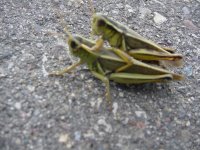
Daily Activity
The obscure grasshopper is a phytophilous species, spending most of each day sitting vertically head up on the stems and leaves of grasses. Observations made shortly after sunrise and before the grasshoppers became active indicate that the night is spent 1 to 2 inches above ground on both grasses and sedges. When the rays of the sun have struck their perches, about one hour after sunrise, both nymphs and adults begin to bask by adjusting their positions so that they directly expose a side or sometimes their back. They may also expose their back by taking diagonal positions on blue grama plants or small soil mounds. Occasionally they are found basking on bare ground, in which case they expose a side and often lower the associated hindleg. During the basking period, ground temperatures range from 70° to 100°F and air temperatures 1 inch above ground level range from 64° to 83°F. Activities such as feeding begin when ground temperature has risen to 85°F and air temperature to 70°F. No observations of their mating have been made in their natural habitat. In the mixedgrass prairie of western South Dakota females have been observed ovipositing into soil adjacent to buffalograss.
Because of their habit of sitting vertically on grasses, they are prone to remain inactive. When nymphs are flushed from their perches, they usually jump onto another plant. Occasionally they land on bare ground but quickly climb a grass leaf or stem. Adults may jump and behave like the nymphs or fly evasively.
High soil temperatures of 110° to 130° and air temperatures at or above 90°F induce the grasshoppers to seek protection. They react in three main ways: they climb up to 4 inches on midgrasses, or they take diagonal positions on blue grama facing the sun to expose less of the body surface, or they rest in the shade under a canopy of vegetation above ground level on blue grama.
Their day ends with basking in the evening rays of the sun while resting vertically on grasses. As sunlight dims and temperatures cool, they eventually assume their nighttime positions.
Adults and Reproduction
The adults generally remain at the same site in which the eggs hatched and the nymphs developed. There they have plenty of blue grama for food and patches of midgrasses for refuge and roosting. First appearance of adults in the mixedgrass prairie of Montana and Wyoming and the shortgrass prairie of Colorado occurs during late July or early August. In Arizona adults appear as early as April. The attrition of adults by parasites and predators goes on daily, and by October few individuals are left alive.
No special study of the obscure grasshopper's mating behavior has been made. In a laboratory terrarium, one observation was made of a male mounting a female and attempting, unsuccessfully, to engage his genitalia with the female's.
Females deposit their eggs deep in the soil and form a pod with weak earthen walls (Fig. 10). The eggs themselves are held together tightly and covered by cementing secretions of the female. An observation of oviposition was made of a caged female in a laboratory terrarium that contained mixedgrass sod and bare ground. The female chose bare ground beneath a 15-watt incandescent bulb. She worked her ovipositor into the soil to the full length of the abdomen and took 100 minutes to complete oviposition, after which she took 20 minutes to withdraw her abdomen and 90 seconds to brush loose soil over the hole with her hind tarsi. Following this parental care she walked away.
Pods of the obscure grasshopper are seven-eighths inch long and contain eight to ten small (4 to 4.3 mm long), pale tan eggs. The eggs overwinter, but no study of their embryology has been made. The species has one generation annually.

0 Comments:
Post a Comment
<< Home